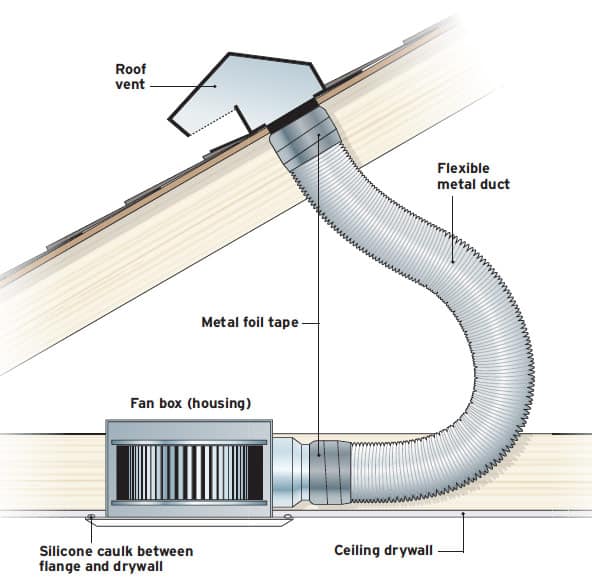The bathroom and toilet must have good ventilation. In these rooms, the humidity increases significantly, and odors, usually unpleasant, are present. Air aromas do not help.
The ventilation system has a fan. Such methods are installed everywhere in private homes, including kitchens and bathrooms. However, not all apartments in tall buildings are adequately ventilated. Therefore, their owners install fans to improve air circulation.
How to Vent a Bathroom Fan Through the Roof?
To vent a bathroom fan through the roof, you first need to drill a 4-inch round hole through the top, remove the asphalt shingles, and install a roof-mounted exhaust vent. Next, you need to apply asphalt roof cement to the bottom of the duct. In the last step, you must nail lower corners with roofing nails.

Tools that you need to Vent a Bathroom Fan Through the Roof are:
- Caulk gun
- Pry bar
- Hammer
- Corded drill
- Jigsaw
Materials that you need to Vent a Bathroom Fan Through the Roof are:
- 4-in. rigid
- Roof-mounted exhaust vent
- Asphalt roof cement
- Roofing nails
The best exhaust fan venting is through smooth, unbending conduits with taped joints and screwed to a unique vent hood. Although this isn’t generally imaginable in loft unfinished plumbing spaces, you should consistently protect the conduit from forestalling buildup issues. You can discover a 4-in pipe previously enveloped with protection at home focuses. If you’re enticed to vent your exhaust fan through a current rooftop vent or even vent it into the upper room, don’t do it. In the first place, you’ll, to some degree, block your rooftop vent with the funneling, decreasing the progression of cooling air through your upper room. Second, during cold winters, you’ll blow warm, damp air onto a virus surface (the rooftop vent and rooftop pressed wood). The water will consolidate and trickle into the protection underneath and maybe into the house. Finally, unique washroom fan rooftop vents with an internal damper that opens when the fan blows will send wet air outside and keep cold air out of the house.
Begin in the attic by drilling a hole through the roof in the appropriate place for the vent. Keep it as close to the fan as possible. Allow the drill bit to protrude through into the ceiling so you can find the hole. Cut a 4-in. piece of plywood with a jigsaw or reciprocating saw from the roof—a circular hole. Next, cut a square somewhat more extensive than the vent’s projecting section. Remove the roofing materials with a hook blade and place it into a utility knife. Pry up the shingles surrounding the hole gently, allowing the vent to go beneath the first layer.
Use asphalt roof cement.
Apply a bead of asphalt roof adhesive to the vent’s base. Slide the vent beneath the tiles so that the upper half of the vent flange is covered. The bottom side of the flange supports the shingles. Lower corners should be nailed using roofing nails, and the heads should be tarred.
Can you vent a bathroom fan into the attic?
No, you can not vent a bathroom fan into the attic because, in attics, too much insulation airflow can keep excess moisture from escaping. Use the roof or the gable wall to install a vent.
How do you install a kitchen hood vent on the roof?
To vent a kitchen fan through the roof, you first need to drill a round hole through the top wider than ductwork, remove the asphalt shingles, and install a roof-mounted exhaust vent. Next, you need to apply asphalt roof cement to the bottom of the duct. In the last step, you must nail lower corners with roofing nails.
Bathroom vents and aerators
To choose correctly and install aerators, you need to follow the following rules:
- The distance between two adjacent devices should be at least 12 meters;
- To block all the floor space evenly, you must install them along the entire length of the roof on the highest parts of the rod;
- You must install special filters on them to avoid inside dirt, dust, and insects.
- Aerators are attached to anchor bolts or unique roof nails.
- Use a particular tape or sealant to remove the grooves and avoid flow.
In addition to the aerator, a comb with fishers that protects the gap can be installed for the same purposes. Roof fans are often included—they are good on flat roofs, where natural blowing is impossible, and on flat tops, where the ventilation is not strong enough.
Conclusion
Vent your shower and kitchen exhaust fans through the rooftop through a unique rooftop hood. Venting through a rooftop vent or debilitating them in the loft could mess dampness up and decay. The best exhaust fan venting is through smooth, unbending conduits with taped joints and screwed to a unique vent hood.





